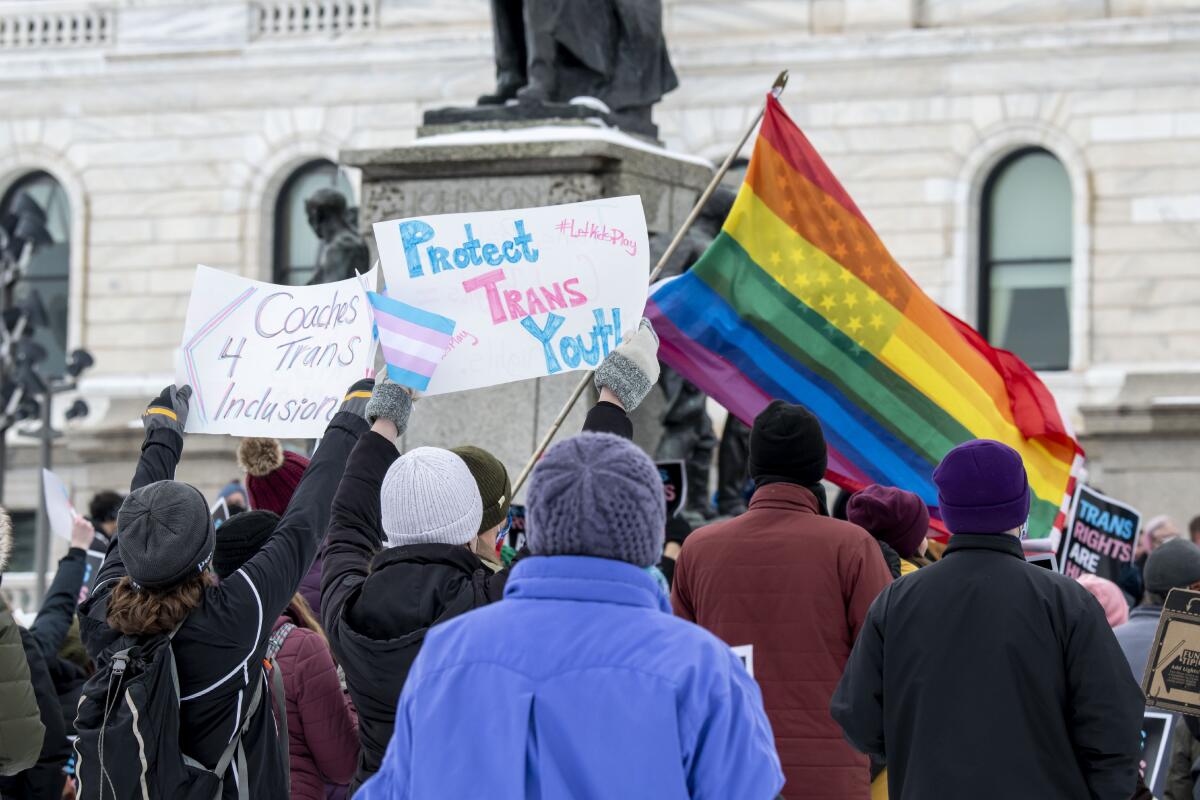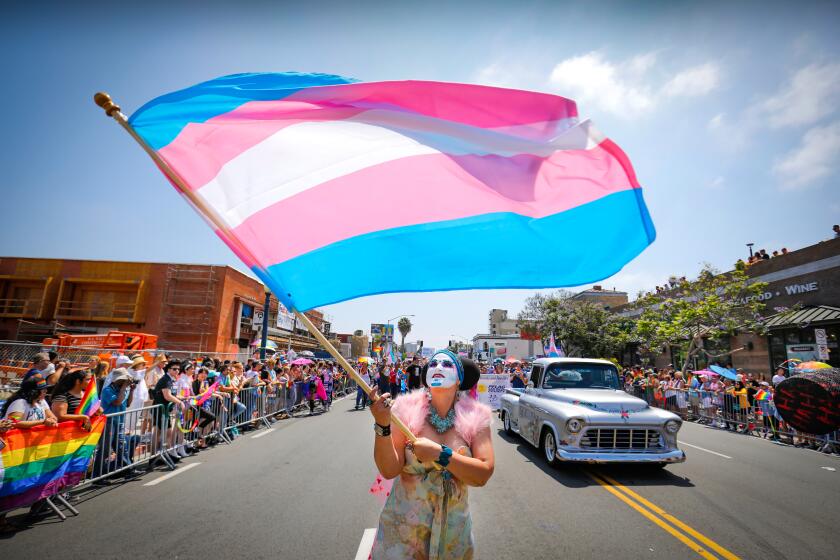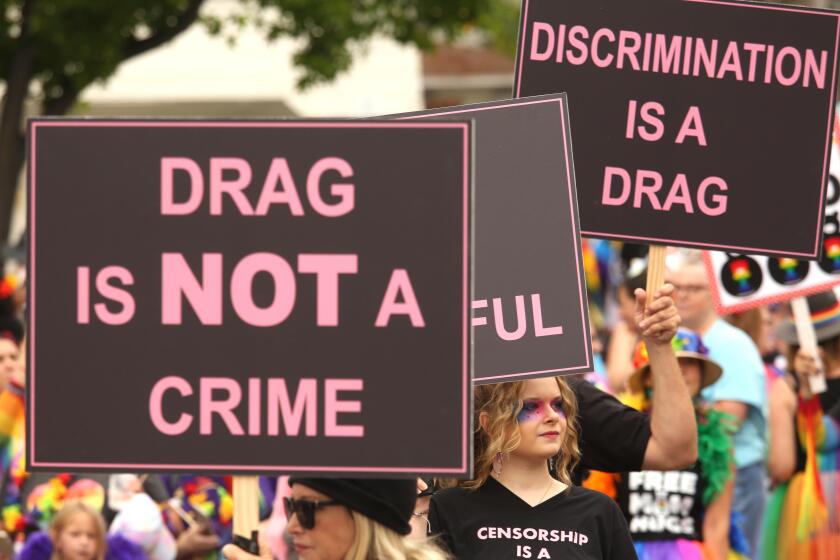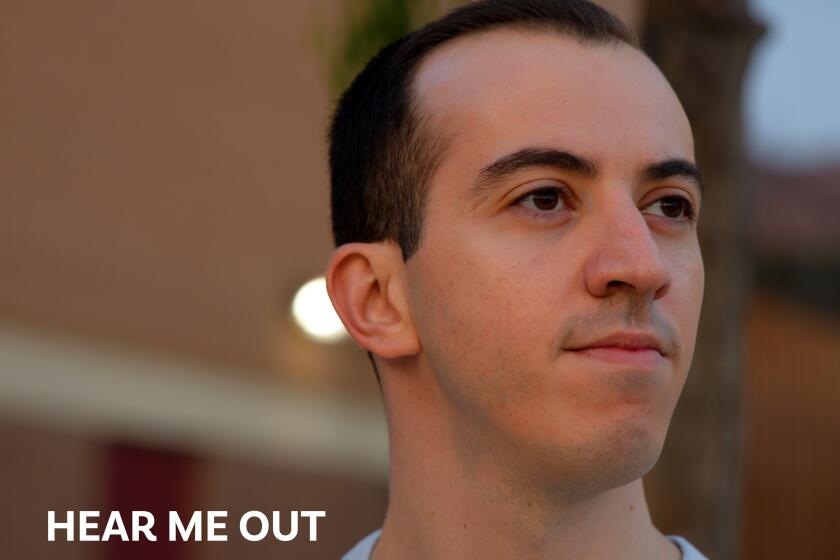Opinion: I’m a trans parent. Here’s what I tell adults who worry when kids are gender-nonconforming

- Share via
I was having brunch recently with my old friend Dan. Halfway through his breakfast burrito, he casually mentioned that his youngest child had started identifying as nonbinary. I’d known Brady since early childhood, and they had always known their own mind and been unafraid to speak it. That they were owning their identity with such ease — bypassing the decades of confusion I went through before realizing I was trans — felt like cause for celebration.
I ordered another cappuccino and asked Dan whether he was having trouble with any part of the process. It had taken him a minute to get his head around the way Brady manifested their identity — a male name and appearance, nonbinary pronouns and the occasional female accessory — but otherwise he couldn’t have been more supportive. He was, however, less convinced about the identities of some of the kids Brady was hanging out with. “You can tell the difference between the ones who are actually trans and the ones who are just along for the ride,” he told me. “Most of them will have grown out of it by the time they leave school.”
Our happiness is largely a product of how we are treated by the people around us.
This assumption that a small number of kids are legitimately trans and the rest are just trying it on for size is something I hear often, usually from parents who are confused by the rising numbers of teenagers identifying as genderqueer. Concerned that trans kids are exerting some kind of influence over the rest of the group, they try to separate gender-nonconforming kids into two categories: those who are assumed to be questioning, curious or going through a “phase” they will eventually grow out of, and those who should be allowed to medically transition into the opposite sex. But this leaves a large space in between, occupied by all the kids who aren’t headed toward either of these outcomes.
The language we’ve started using to describe these kids’ experiences is part of the problem. I hear it among even the most liberal parents: whispers of “social transition,” the specter of “social contagion,” the potential horror of “detransition.” It speaks to the concern that vulnerable children might be lured out of the “going through a phase” group and into the “medical intervention” group, setting them on what these parents fear is an irreversible pathway toward puberty blockers, cross-sex hormones and potential surgery. This is the fear that makes so many parents pause when asked about gender-affirming care for adolescents and prevents them from putting their wholehearted support behind the trans community.
Q. is remarkably tuned in to the national conversation and laws that put queer people in danger. She knows it’s not safe for her to truly emerge.
When people have fears they find hard to articulate, loaded phrases can give them inaccurate ideas. The word “transition” in this context was coined by cisgender doctors to describe only what they observed from outside the process: a person apparently crossing from one sex to another. Now the term “social transition” has become a catch-all to describe the behavior of any kid who appears to be deviating from gender norms. But including “transition” in that phrase has triggered panic that they’re all stepping onto an imaginary bridge that leads in only one direction.
Back in the 1970s and ’80s, when I was growing up, it wasn’t called a “social transition” when queer kids borrowed clothes from the opposite sex because nobody assumed they were on a linear path from one sex to another. They were just trying to figure themselves out and make themselves legible through their presentation.
If we reimagine what Brady and their friends are doing as “alignment” rather than “transition,” then whether any of them will require medical intervention depends entirely on what they need to do to align their outsides with their identities. Whether they’re dyeing their hair, changing their names, experimenting with pronouns or trying to modify their secondary sex characteristics, all they’re doing is responding to that voice inside them telling them who they are.
Taron Sargsyan overcame addiction. Now, he wants other LGBTQ+ students in California to feel supported so they don’t have to experience the pain he endured.
If we look at these actions as what they are — part of a commitment to authenticity — it should alleviate the misplaced fear of social contagion. Just as “social transition” isn’t a first step onto an imaginary one-way bridge, “social contagion” isn’t going to pull anyone across that bridge against their will.
While it’s true that adolescents are hypersensitive to the opinions of their peers and will go to great lengths to prevent exclusion, the share of kids who identify as gender-nonconforming is far too small to override the overwhelming influence of the vast cisgender majority. The pressure to conform comes — as it always has — from the masses. Gender-incongruent kids, who have resisted the pressure to be cisgender and heterosexual — in other words, to be “normal” — form cliques with each other for safety and support. This isn’t social contagion; it’s solidarity.
Our individual evolutions also aren’t as linear as the concept of “detransition” makes them out to be. We don’t magically stop forming at the end of puberty. We continue to evolve. Our genders may fluctuate as we go through the various stages of life, our sexual orientations may change, and our bodies certainly will. We all spend our lives in a constant state of micro-adjustment, realigning ourselves as our circumstances alter and our desires shift. Trans people are not fundamentally different from everyone else; we’ve just been scrutinized so much that people believe we are.
It’s time for everyone to take a leaf out of Dan’s book and start trusting gender-nonconforming kids more. Tap into their joy, listen to how playful they are with language, imagine the words they use as metaphors rather than medical diagnoses. Genuinely supporting all children equally — no matter how they identify — is the kind of social transition we should all be trying to make.
Oliver Radclyffe is a parent of four children and the author of the memoir “Frighten the Horses.”
More to Read
A cure for the common opinion
Get thought-provoking perspectives with our weekly newsletter.
You may occasionally receive promotional content from the Los Angeles Times.













